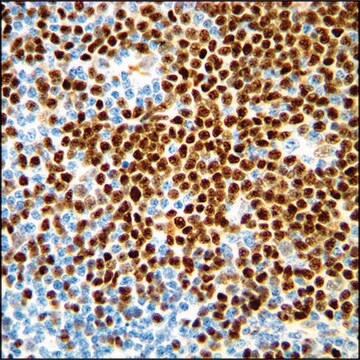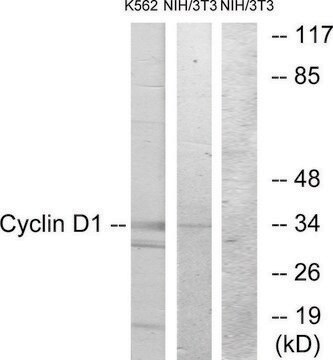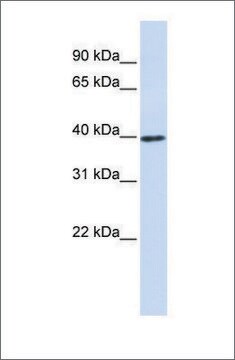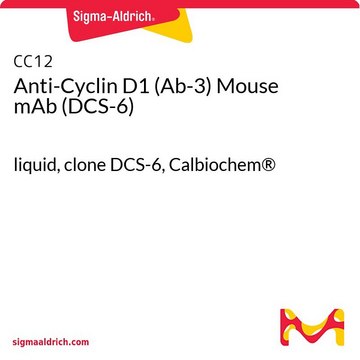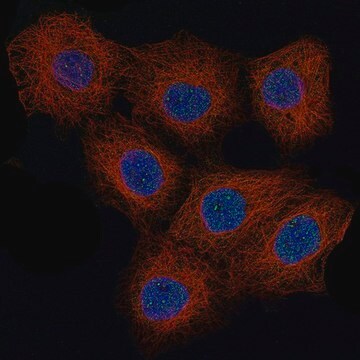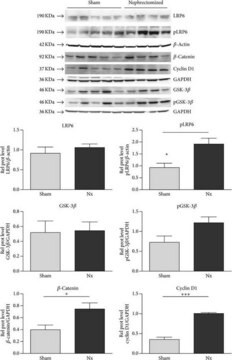SAB4700017
Monoclonal Anti-CCND1 antibody produced in mouse
clone CD1.1, purified immunoglobulin, buffered aqueous solution
Synonym(s):
Anti-cyclin D1
Sign Into View Organizational & Contract Pricing
All Photos(1)
About This Item
UNSPSC Code:
12352203
NACRES:
NA.41
Recommended Products
biological source
mouse
Quality Level
conjugate
unconjugated
antibody form
purified immunoglobulin
antibody product type
primary antibodies
clone
CD1.1, monoclonal
form
buffered aqueous solution
species reactivity
human, rat
concentration
1 mg/mL
technique(s)
flow cytometry: suitable
isotype
IgG1
NCBI accession no.
UniProt accession no.
shipped in
wet ice
storage temp.
2-8°C
target post-translational modification
unmodified
Gene Information
human ... CCND1(595)
General description
The antibody CD1.1 recognizes cyclin D1, an ubiquitously expressed 33 kDa protein that migrates as a 36 kDa band under reducing SDS-PAGE conditions.
Immunogen
Purified cyclin D1 protein
Application
The reagent is designed for Flow Cytometry analysis. Suggested working dilution for Flow Cytometry is 2-8 μg/mL of sample. Indicated dilution is recommended starting point for use of this product. Working concentrations should be determined by the investigator.
Features and Benefits
Evaluate our antibodies with complete peace of mind. If the antibody does not perform in your application, we will issue a full credit or replacement antibody. Learn more.
Physical form
Solution in phosphate buffered saline, pH 7.4, with 15 mM sodium azide.
Not finding the right product?
Try our Product Selector Tool.
Storage Class Code
10 - Combustible liquids
Flash Point(F)
Not applicable
Flash Point(C)
Not applicable
Choose from one of the most recent versions:
Already Own This Product?
Find documentation for the products that you have recently purchased in the Document Library.
Wei Yang et al.
Experimental cell research, 326(1), 22-35 (2014-06-17)
Glioma contains abundant hypoxic regions which provide niches to promote the maintenance and expansion of glioma stem cells (GSCs), which are resistant to conventional therapies and responsible for recurrence. Given the fact that miR-210 plays a vital role in cellular
Ehab H Sarsour et al.
Age (Dordrecht, Netherlands), 36(3), 9645-9645 (2014-04-03)
Cancer is an age-associated disease. Although the mechanisms of age-associated increase in cancer incidence are not completely understood, it is believed that the tumor stromal environment significantly influences epithelial malignancy. Fibroblasts are a major cell type in the stroma and
Pavla Veselá et al.
Virchows Archiv : an international journal of pathology, 465(5), 587-597 (2014-07-23)
The clinical course and therapy of mantle cell lymphoma (MCL) are heterogeneous and often unsatisfactory. Prognostic factors are needed to stratify the patients. Microvessel density (MVD) has prognostic significance in some malignancies. There is little information about the vasculature of
Cristian P Moiola et al.
Clinical cancer research : an official journal of the American Association for Cancer Research, 20(15), 4086-4095 (2014-05-21)
Clinical and epidemiologic data suggest that obesity is associated with more aggressive forms of prostate cancer, poor prognosis, and increased mortality. C-terminal-binding protein 1 (CtBP1) is a transcription repressor of tumor suppressor genes and is activated by NADH binding. High
Mianmian Yin et al.
The Journal of biological chemistry, 289(26), 18239-18257 (2014-05-16)
Our previous studies have shown that microRNA-320 (miR-320) is one of the most down-regulated microRNAs (miRNA) in mouse ovarian granulosa cells (GCs) after TGF-β1 treatment. However, the underlying mechanisms of miR-320 involved in GC function during follicular development remain unknown.
Our team of scientists has experience in all areas of research including Life Science, Material Science, Chemical Synthesis, Chromatography, Analytical and many others.
Contact Technical Service